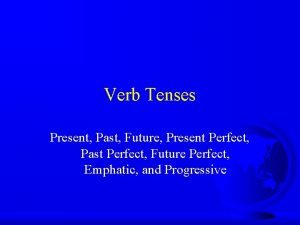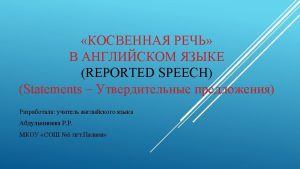Past Present Future of MW SSTs Chelle L











- Slides: 11

Past, Present, Future of MW SSTs Chelle L. Gentemann & Frank J. Wentz Remote Sensing Systems Santa Rosa, CA NASA SST Science Team Meeting November 2010 gentemann@remss. com

Outline • Past • Present • Future

TMI and AMSRE • SSTs from these instruments have been incorporated into operational NWP products, numerous scientific publications, and are used for fisheries applications. • Accuracy 0. 5 K

Key successes • Demonstrated positive impact of AMSR-E SSTs on hurricane track forecasts (Navy), hurricane intensity forecasts (NOAA), operational SST products (NOAA and Navy). • US Navy operationally utilizes AMSR-E SSTs in their K 10 analysis and is experimenting with using it in their NOGAPS SST • NOAA is operationally utilizing AMSR-E SSTs in their N-AWIPS workstations • Operational weather/ocean forecasting use of AMSR-E SSTs – Australia: Bureau of Meteorology Bluelink SSTs – France: IFREMER/CERSAT Odyssea – UK: Met Office OSTIA-SST

Public Impacts • AMSR-E OI SSTs used in “An inconvenient Truth” • Imagery prepared by NASA SVS

Science Impacts • Huge number of journal articles • The Effects of SST-Induced Surface Wind Speed and Direction Gradients on Midlatitude Surface Vorticity and Divergence, Larry W. O’Neill, Dudley B. Chelton, Steven K. Esbensen. Journal of Climate, Volume 23, Issue 2 (January 2010) pp. 255 -281 High-Resolution Satellite Measurements of the Atmospheric Boundary Layer Response to SST Variations along the Agulhas Return Current Larry W. O’Neill, Dudley B. Chelton, Steven K. Esbensen, Frank J. Wentz. Journal of Climate Volume 18, Issue 14 (July 2005) pp. 2706 -2723 Dynamical Analysis of the Boundary Layer and Surface Wind Responses to Mesoscale SST Perturbations Larry W. O’Neill, Steven K. Esbensen, Nicolai Thum, Roger M. Samelson, Dudley B. Chelton. Journal of Climate Volume 23, Issue 3 (February 2010) pp. 559 -581 doi: 10. 1175/2009 JCLI 2662. 1 Frontal Scale Air-Sea Interaction in High-Resolution Coupled Climate Models Frank O. Bryan, Robert Tomas, John M. Dennis, Dudley B. Chelton, Norman G. Loeb, Julie L. Mc. Clean. Journal of Climate Volume 0, Issue 0 ( ) pp. doi: 10. 1175/2010 JCLI 3665. 1 Location of the Antarctic Polar Front from AMSR-E Satellite Sea Surface Temperature Measurements Shenfu Dong, Janet Sprintall, Sarah T. Gille. Journal of Physical Oceanography Volume 36, Issue 11 (November 2006) pp. 2075 -2089 Observations of SST-Induced Perturbations of the Wind Stress Field over the Southern Ocean on Seasonal Timescales Larry W. O'Neill, Dudley B. Chelton, Steven K. Esbensen. Journal of Climate Volume 16, Issue 14 (July 2003) pp. 2340 -2354 An Assessment of the Southern Ocean Mixed Layer Heat Budget Shenfu Dong, Sarah T. Gille, Janet Sprintall. Journal of Climate Volume 20, Issue 17 (September 2007) pp. 4425 -4442 Subseasonal SST Variability in the Tropical Eastern North Pacific during Boreal Summer Eric D. Maloney, Dudley B. Chelton, Steven K. Esbensen. Journal of Climate Volume 21, Issue 17 (September 2008) pp. 4149 -4167 doi: 10. 1175/2007 JCLI 1856. 1 Monsoon Breaks and Subseasonal Sea Surface Temperature Variability in the Bay of Bengal Gabriel A. Vecchi, D. E. Harrison. Journal of Climate Volume 15, Issue 12 (June 2002) pp. 1485 -1493 Observations of Coupling between Surface Wind Stress and Sea Surface Temperature in the Eastern Tropical Pacific Dudley B. Chelton, Steven K. Esbensen, Michael G. Schlax, Nicolai Thum, Michael H. Freilich, Frank J. Wentz, Chelle L. Gentemann, Michael J. Mc. Phaden, Paul S. Schopf. Journal of Climate Volume 14, Issue 7 (April 2001) pp. 1479 -1498 …. • • •

Primary sources of uncertainty • Errors in retrieval algorithm (specification of wind direction, anomalous atmospheric conditions) • RFI (undetected) from geostationary satellites • Sunglint (data flagging) • Rain contamination (data flagging) • Land contamination (data flagging) • Calibration (usually correctable)

PMW Radiometers (SST capable) Instrument Name Short Instrument Name Full Instrument Agencies RAD Microwave radiometer NSOAS GMI GPM Microwave Imager NASA Advanced MTVZA AMSR-2 AMSR-E Advanced Scanning microwave ROSHYDROMET imager-sounder Advanced Microwave JAXA Scanning Radiometer -2 Advanced Microwave JAXA (NASA) Scanning Radiometer-EOS Instrument Status Being developed 2011 launch Being developed 2014 launch Proposed 2014 launch Approved 2/2012 launch Wavebands (GHz) 6. 6, 10. 7, 18. 7, 23. 8, 37. 0 10. 7, 19. 4, 21. 3, 37, 85. 5 10. 6 - 183. 3 GHz, 26 channels 6. 9, 7. 3, 10. 7, 18. 7, 23. 8, 36. 5, 89. 0 Operational 6. 9, 10. 7, 18. 7, 23. 8, 36. 5, 89. 0 Operational 10. 7, 19. 4, 21. 3, 37, and 85. 5 Scanning microwave imager. ROSHYDROMET sounder Operational 10. 6 - 183. 3 GHz, 26 channels MWRI Micro. Wave Radiation Imager NRSCC (CAST) Operational 10. 65, 18. 7, 23. 8, 36. 5, 89, 150 Wind. SAT Coriolis NPP Operational 6. 8, 10. 7, 18. 7, 23. 8, and 37 MSMR Multifrequency Scanning Microwave Radiometer ISRO Dead 6. 6, 10. 6, 18 & 21 TMI MTVZA TRMM Microwave Imager Source: CEOS EO Handbook NASA

GCOM-W AMSR 2 • • • MIDORI AMSR… Engineering details Hot load New channel to minimize RFI New algorithms…

US AMSR 2 SST • NASA currently funding SALMON proposal to produce AMSR 2 data • NOAA wants to produce NRT AMSR 2 operationally

Summary • The continuity of MW SSTs is uncertain and relies upon a successful JAXA GCOM-W AMSR 2. Any failures or delays will result in an interruption of the MW SST climate record • Future NASA PMW sensors (GMI) are not considering SST important • Reliance on international sensors inescapable, but funding for work on non-US sensors is scarce (2008 SALMON USPI made 6 awards (AMSR 2, MERIS, China Landsat, LARES, SMILES, EC-CPR) • Since GCOMW AMSR 2 is now JPSS official replacement for MIS, US ST possible? • Will the US fly another MW radiometer that is SSTcapable? • MSMR data ? Valuable dataset, low resolution….
 Present past future simple present continuous exercises
Present past future simple present continuous exercises Past simple future
Past simple future Present simple past simple future simple
Present simple past simple future simple Present simple and future simple
Present simple and future simple Future perfect see
Future perfect see Future perfect simple and continuous
Future perfect simple and continuous Past simple past continuous or past perfect
Past simple past continuous or past perfect Present past future simple
Present past future simple Past simple future simple
Past simple future simple Present continuous tense
Present continuous tense Past present and future tense verbs
Past present and future tense verbs![[cmopeed] [cmopeed]](data:image/svg+xml,%3Csvg%20xmlns=%22http://www.w3.org/2000/svg%22%20viewBox=%220%200%20200%20200%22%3E%3C/svg%3E) [cmopeed]
[cmopeed]











![[cmopeed] [cmopeed]](https://slidetodoc.com/wp-content/uploads/2020/11/1824741_49833cec68ae151f6a8196a06ace6f42-300x225.jpg)








